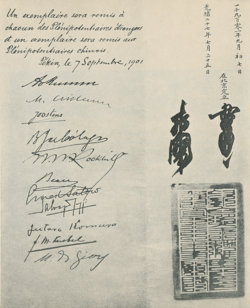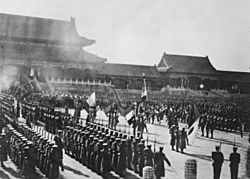Boxer Protocol facts for kids
| China and the 11 countries' final agreement on compensation for the 1900 turmoil | |
|---|---|

Signature page of representatives of various countries on the Boxer Protocol settlement
|
|
| Type | Unequal treaty |
| Signed | September 7, 1901 (July 25th, Year Guangxu 27) (Chinese: 光緒) |
| Location | Daqing Jingshi Spanish Embassy |
| Signatories |
|
| Parties | |
| Depositary | National Palace Museum, Taipei City |
| Language | Chinese, French (The agreement is based on French) |
| Boxer Protocol | |||||||||||||
|---|---|---|---|---|---|---|---|---|---|---|---|---|---|
| Traditional Chinese | 1. 辛丑條約 2. 辛丑各國和約 3. 北京議定書 |
||||||||||||
| Simplified Chinese | 1. 辛丑条约 2. 辛丑各国和约 3. 北京议定书 |
||||||||||||
| Literal meaning | 1. Xinchou (year 1901) treaty 2. Xinchou (year 1901) all-nation peace treaty 3. Beijing protocol |
||||||||||||
|
|||||||||||||
The Boxer Protocol was an important agreement signed on September 7, 1901. It was made between the Qing Empire (China's government at the time) and eleven other countries. These countries included the Eight-Nation Alliance (Austria-Hungary, France, Germany, United Kingdom, Italy, Japan, Russia, and the United States), plus Belgium, Spain, and the Netherlands. This agreement happened after China lost the fight to stop the Boxer Rebellion. Many people see it as one of the "unequal treaties" because it put China at a disadvantage.
What is the Boxer Protocol?
The agreement signed in 1901 is usually called the Boxer Protocol in English. Sometimes it's also known as the Peace Agreement between the Great Powers and China. In Chinese, it's called the "Xinchou Treaty." "Xinchou" refers to the year 1901, when the agreement was signed.
The full official name of the protocol in English is quite long: Austria-Hungary, Belgium, France, Germany, Great Britain, Italy, Japan, Netherland, Russia, Spain, United States and China – Final Protocol for the Settlement of the Disturbances of 1900. This long name shows it was a special diplomatic agreement, not just a regular peace treaty.
How the Agreement Was Reached
When the foreign armies took control of Beijing, the Qing dynasty was not completely defeated. The foreign powers had to be careful with their demands. They sent a message to Empress Dowager Cixi in Xi'an, where she had fled. They wanted her to agree to the terms. For example, China did not have to give up any land.
Many of the Empress Dowager's advisors wanted to keep fighting. They believed China could still win. They thought that disloyal people inside China were the reason Beijing and Tianjin were captured. They also felt that the inner parts of China were safe from foreign armies. However, the Empress Dowager was practical. She decided the terms were fair enough to stop the war, especially since she was allowed to continue ruling China.
Who Signed the Agreement?
The Boxer Protocol was signed on September 7, 1901. The signing took place at the Spanish Legation (like an embassy) in Beijing.
Countries That Signed
Here are the countries and their representatives who signed the agreement:
 Kingdom of Spain, represented by Bernardo J. de Cólogan y Cólogan. He was the most senior diplomat there.
Kingdom of Spain, represented by Bernardo J. de Cólogan y Cólogan. He was the most senior diplomat there. United Kingdom of Great Britain and Ireland, represented by Ernest Mason Satow.
United Kingdom of Great Britain and Ireland, represented by Ernest Mason Satow. Russian Empire, represented by Mikhail Nikolayevich von Giers.
Russian Empire, represented by Mikhail Nikolayevich von Giers. Empire of Japan, represented by Komura Jutarō.
Empire of Japan, represented by Komura Jutarō. French Republic, represented by Paul Beau.
French Republic, represented by Paul Beau. United States of America, represented by William Woodville Rockhill.
United States of America, represented by William Woodville Rockhill. German Empire, represented by Alfons Mumm von Schwarzenstein.
German Empire, represented by Alfons Mumm von Schwarzenstein. Austro-Hungarian Empire, represented by Baron Moritz Czikann von Wahlborn.
Austro-Hungarian Empire, represented by Baron Moritz Czikann von Wahlborn. Kingdom of Italy, represented by Giuseppe Salvago Raggi.
Kingdom of Italy, represented by Giuseppe Salvago Raggi. Kingdom of Belgium, represented by Maurice Joostens.
Kingdom of Belgium, represented by Maurice Joostens. Kingdom of the Netherlands, represented by Fridolin Marinus Knobel.
Kingdom of the Netherlands, represented by Fridolin Marinus Knobel.
And for China:
 Qing Empire, represented by:
Qing Empire, represented by:
- Li Hongzhang, a very important official and minister.
- Yikuang, also known as Prince Qing, who was the first Prime Minister.
Key Parts of the Agreement

The Boxer Protocol included several important rules and demands for China:
- Payment to Foreign Powers: China had to pay a huge amount of money, 450 million taels of silver, to the eleven countries. This was called an indemnity. It was like a penalty payment for the damages and costs of the rebellion. This payment was to be made over 39 years, with interest. The total amount would be almost 1 billion taels by 1940.
- No More Weapons: China was not allowed to import weapons or ammunition for at least two years. This could be extended if the foreign powers felt it was necessary.
- Destroying Forts: The Taku Forts, which protected the approach to Beijing, had to be destroyed.
- Special Foreign Areas: Foreign countries were given special areas in Beijing called Legation Quarters. These areas were only for foreigners, and Chinese people were not allowed to live there. The foreign countries could also keep their own guards to protect their legations.
- Punishing Officials: Chinese officials and Boxers who had harmed foreign governments or their citizens were to be punished.
- New Foreign Office: The "Office in Charge of Affairs of All Nations" (Zongli Yamen) was replaced with a new Foreign Office. This new office was ranked higher than other government departments.
- Stopping Anti-Foreign Groups: The Chinese government had to make it illegal to join any group that was against foreigners. Anyone who joined such a group could face the death penalty. Also, civil service exams were stopped for five years in areas where foreigners were harmed. Local officials would be held personally responsible for any new incidents against foreigners.
- Apologies to Emperors: The emperor of China had to apologize to the German emperor for the killing of Baron von Ketteler. He also had to apologize to the emperor of Japan for the killing of Mr. Sugiyama.
- Commemorative Arch: A special arch had to be built where Baron von Ketteler was killed. It would have inscriptions in Latin, German, and Chinese.
- Foreign Troops in China: The foreign powers were allowed to station their troops in several places in China. This meant foreign soldiers could be permanently based in these areas.
| Traditional Chinese | Simplified Chinese | Pinyin | Transliterated names from early text using a system that pre-dates Pinyin |
|---|---|---|---|
| 黃村 | 黄村 | Huangcun | Huang-tsun |
| 郎坊(廊坊) | 郎坊(廊坊) | Langfang | Lang-fang |
| 楊村 | 杨村 | Yangcun | Yang-tsun |
| 天津 | 天津 | Tianjin | Tien-tsin |
| 軍糧城 | 军粮城 | Junliangcheng | Chun-liang-Cheng |
| 塘沽 | 塘沽 | Tanggu | Tong-ku |
| 蘆臺 | 芦台 | Lutai | Lu-tai |
| 唐山 | 唐山 | Tangshan | Tong-shan |
| 灤州 | 滦州 | Luanzhou | Lan-chou |
| 昌黎 | 昌黎 | Changli | Chang-li |
| 秦皇島 | 秦皇岛 | Qinhuangdao | Chin-wang Tao |
| 山海關 | 山海关 | Shanhaiguan | Shan-hai Kuan |
Demands China Refused
The Qing government did not agree to all the demands made by the foreign powers. For example, the Manchu Governor Yuxian was executed as demanded. However, the Imperial court refused to execute the Chinese General Dong Fuxiang. Both men were known for being against foreigners and were accused of encouraging harm against foreigners during the rebellion. Instead, General Dong Fuxiang was allowed to live a comfortable life in "exile" in his home province.
Also, the foreign powers wanted to send Prince Zaiyi, who supported the Boxers, to Xinjiang. But the Qing government refused. He instead moved to Alashan, and later to Ningxia during the Xinhai Revolution.
How the Money Was Used
Over time, some countries decided to change how China's indemnity payments were used.
- United States: In 1908, the United States returned a large part of its share of the money to China. This money was used to help Chinese students study in the United States. It also helped build Tsinghua University in Beijing.
- Germany and Austria: When China joined World War I in 1917 and declared war on Germany and Austria, it stopped paying their share of the indemnity. At the Paris Peace Conference after the war, Beijing successfully got Germany and Austria's shares completely cancelled.
- Russia/Soviet Union: The story of Russia's share is more complicated. In 1918, the Bolsheviks (who took over Russia) said they would cancel Russia's share. However, later, the Soviet Union wanted to control how the money was spent. They eventually agreed that Russia's share would be used for education in China, but the Soviet government would still decide how it was used.
- Other Countries:
- In 1925, Great Britain arranged for its share to be used for railway construction in China.
- France wanted its money to reopen a Chinese-French bank.
- Italy used its share to build steel bridges.
- The Netherlands used its money for harbor improvements and for setting up a Chinese studies institute at Leiden University.
- Belgium's funds were set aside for railway materials from Belgium.
- Japan's indemnity was used to develop aviation in China, with Japanese oversight.
By 1927, China had managed to change almost all of the Boxer Indemnity payments. Most of the money was now being used for projects and education within China itself, rather than being sent abroad.
See Also
- China Relief Expedition
- Boxer Rebellion
- Mutual Protection of Southeast China
- Beijing Legation Quarter
- Imperial Decree on events leading to the signing of Boxer Protocol
- China Consortium
Images for kids




